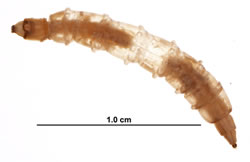
Reproduction
In the genus Tabanus, reproduction starts with courtship of females to males. Male flies form large swarms, commonly in the morning, over swamps or moist soil (Gordh and Headrick 2001).Virgin females are attracted to the swarms and enter. Airborne copulation is initiated with one male fly, and females become inseminated on the ground (Gordh and Headrick 2001). Females lay their eggs in clusters of up to 200-400 on vegetation overhanging swamps or wet soil. Once the egg are matured into larvae, they hatch from a cocoon-like pupal shell in late spring to early summer. The larva are either predacious or cannibalistic (Gordh and Headrick 2001). Their life cycle involves a change from a wingless soft body to hard winged adult, and as a fly, they are holometabolic. To find out where this species is most prolific you can go to the habitat page of this website.
Image of larval stage of family Tabanidae
